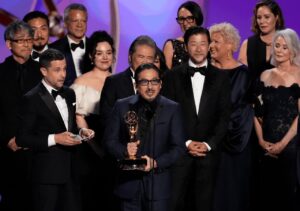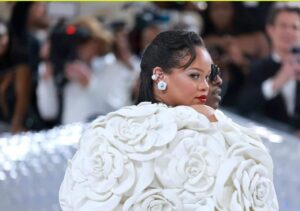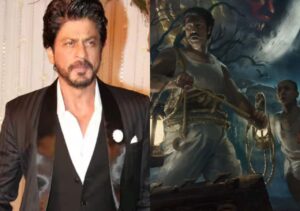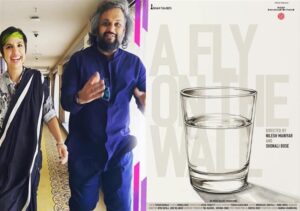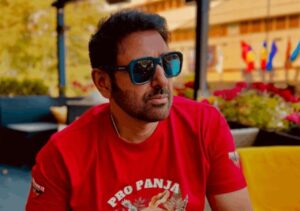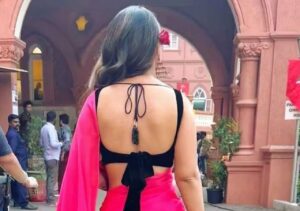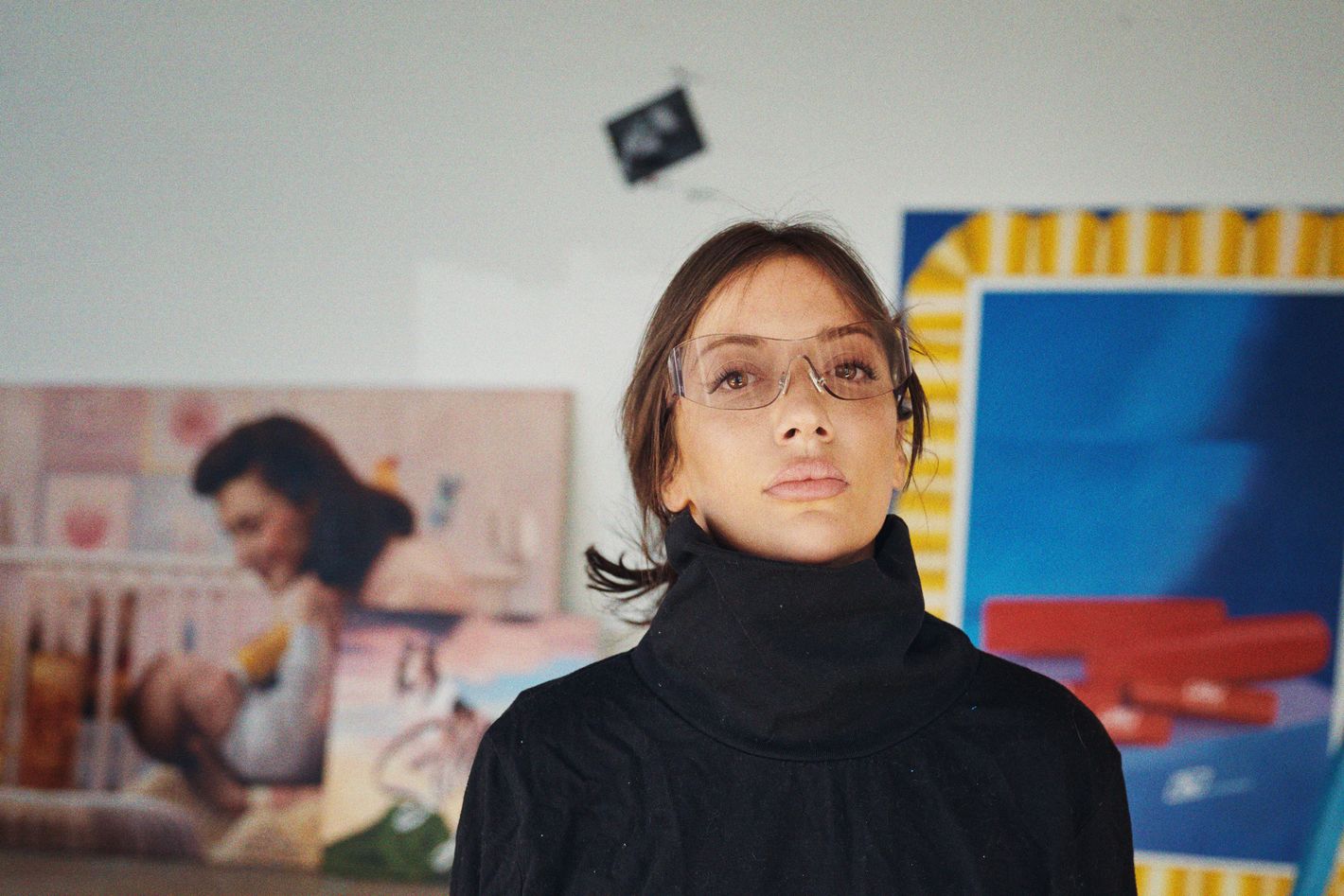
It was St. Patrick’s Day weekend 2024, and it was so crowded inside the Gagosian showroom that had taken over Mary Boone’s old gallery on West 24th Street that I could barely see the paintings. Downtown rats, art-school students, several generations of art stars, musicians, Hypebeast editors, collectors, writers, academics, Harold Ancart, Leo Fitzpatrick (bumming out cigs), Jennifer Lawrence — all there for Jamian Juliano-Villani’s solo show. There was a line down the block. Juliano-Villani, a head shorter than most, entered with “I need a fuckin’ drink!” in her Newport 100’s New Jersey growl. Matt Dillon followed, arm in arm with her mom.
There was art, too: big, expensive (up to $200,000 apiece), ironic oil paintings. A portrait of Henry Kissinger against an I Spy background; another that read STEAMY LITTLE JEWISH PRINCESS with the T’s replaced by the Western Beef cactus. The showstopper was on the front wall: Juliano-Villani, larger than life-size in track pants and ASICS sneakers, staring blankly ahead while squeezing Elvis’s crotch.
Juliano-Villani played Pied Piper as the horde headed back to O’Flaherty’s, the East Village gallery she started in 2021 with friends Billy Grant and Ruby Zarsky, for the after-party. They were showing the work of 82-year-old sculptor Donna Dennis. Techno blasted as pockets of light illuminated Dennis’s enormous sculptures of houses and hotels, detailed down to the front porches — the same pieces that launched her career in the ’70s. Juliano-Villani was behind the bar-slash-desk, handing out shots of Evan Williams whiskey. That party went on until nearly 6 a.m.
Jamian Juliano-Villani is a 37-year-old, five-foot-two, 93-pound art-world bada-bing Betty Boop, the Lower East Side’s Lee “Scratch” Perry, a multi-talented madwoman. Her motto is “Keep it simple, stupid,” said with a Beavis and Butt-head giggle, like a kid lighting firecrackers in the backyard. “Either it’s cool or it sucks.” Everybody knows her; many people worry about her; some people just find her annoying. But nobody is more successful at making the sterile, uptight, investment-advisory version of the art world we’re stuck with feel dangerous again. And fun. She’s both a throwback and maybe a way forward.
She broke into the industry in the 2010s, making collage-style paintings of images dredged from the far corners of the internet, mixing fashion advertising and pieces of Bruce Nauman photos, combining underground cartoons and printed lyrics from John Lennon’s “Imagine.” “My paintings are like a car crash,” she told me. Over the next decade, her work would end up at the Guggenheim and the Whitney and in the collections of Jeffrey Deitch and Alex Katz.
But her greatest art project is probably O’Flaherty’s, which she said she funds primarily by selling her own art at high-end galleries, then funneling money back into her downtown art community by putting on all-night shows with artists who have mostly fallen out of favor. She relaunches neglected careers: Dennis showed at Marlborough Gallery scion Max Levai’s Montauk gallery after her O’Flaherty’s exhibition; ’80s art star Ashley Bickerton got a Gagosian solo show. Comebacks are not easy in the Darwinian art world, but Juliano-Villani has become an expert in rehab. “We find these people because we have really good taste,” she told me. “And they want to show with us because they can do things with us they don’t feel like they can do anywhere else.”
Juliano-Villani’s process, though, is a high-stakes game of one-upmanship with every exhibition feeling as if she’s pulling off some grand caper. She’s always all in, ready to lose everything. Less than six months after her Gagosian show, O’Flaherty’s shuttered, the money was gone, and she was planning the next biggest show of her life.
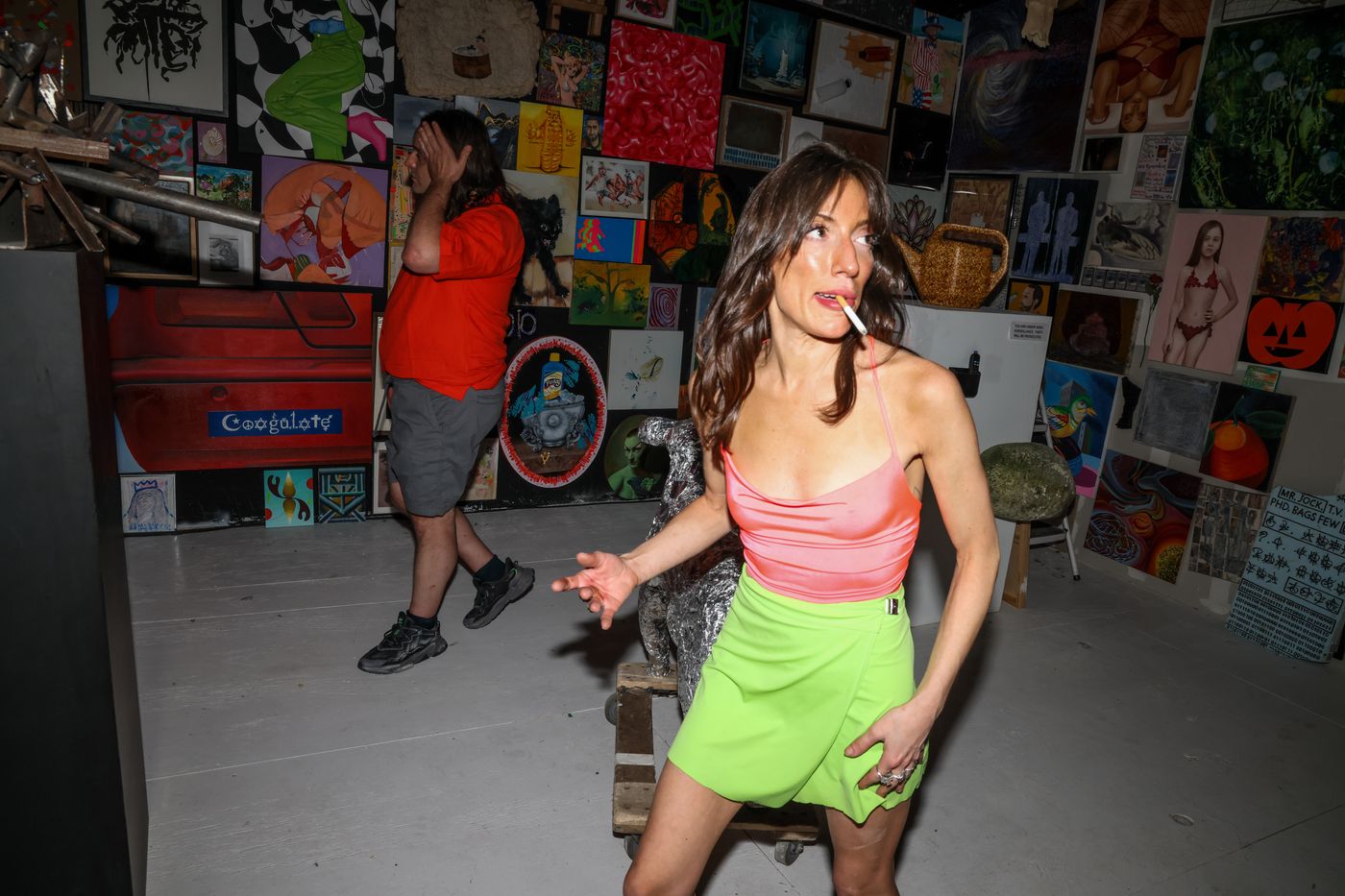
The weekend before the Gagosian exhibit, Juliano-Villani and Grant sat behind their shared desk at O’Flaherty’s discussing strategies with their publicist, Kaitlin Phillips. Grant is five-seven, gentle, nervous, with long and sharp features, beady eyes, black hair parted down the middle, and bad posture. He’s 40 and has lived on Juliano-Villani’s couch on and off over the years; they’re best friends and business partners. She describes their relationship as like Pinky and the Brain; Grant is, I think, the Brain. Through his teens and 20s, he was part of a Virginia Beach artists collective called Dearraindrop, known for its Day-Glo collages; he went on to assist the artist Brian Belott, who introduced him to Juliano-Villani. The first time he went to her house in Bed-Stuy, Juliano-Villani asked him to finish one of her paintings. She left him with it, and when she came back, “It looked like some fucking insane monster of a thing,” she said. “It was out of control. I was like, He’s fucked up just like me.”
The debate that day was whether to be transparent about the fact that Juliano-Villani’s pieces for the Gagosian show were made by a team of painters in China. “We should fly the whole village to the opening,” she said. “If we don’t tell anyone and Roberta walks in thinking Jamian painted them, is that a disaster?” Phillips asked, referring to the New York Times’ longtime art critic Roberta Smith. “It’s about speed,” Grant countered. “If Jamian is painting for months, it wouldn’t be the same. Besides, all big artists use teams” — which is true, but not all artists design their paintings and then send the ideas and dimensions to Chinese fabricators. Juliano-Villani’s outsourcing to China goes back to at least 2018, when she participated in a group show at Shanghai’s Yuz Museum curated by Maurizio Cattelan (who also is known for not making his work with his own hands). The theme was copying, so she decided to make a knockoff version of one of her own paintings. Getting it fabricated in China made sense; she could avoid shipping and customs charges. It was 3 p.m., and Juliano-Villani swigged some whiskey and lit a cigarette. “The point is it lets me paint more. Boots!” Boots is her signal with Grant to move on to another topic. The whole conversation was going on too long. In the end, Phillips convinced her not to fly in the artisans for the opening.
Juliano-Villani got her first art-world job in 2011. Trawling NYFA, a sort of Craigslist for unemployed creatives, she found that the painter Erik Parker was looking for an assistant. “I went there and lied to him about being able to paint,” she said. “She didn’t know how to paint,” said the artist Ajay Kurian, a friend of Juliano-Villani’s. “But I saw her learn. She learned art history. She kept getting better and better, and nothing was beneath her.” She rented a series of studios, including one in East Williamsburg next to the artist Josh Smith, whom she met through Parker. “She put in the work,” Smith told me. “I know, because she would play Weezer on repeat in the alley until dawn.” In the meantime, she documented her taste on Instagram, posting niche memes, party pictures, and her own supercharged paintings of, for instance, herself as a blow-up sex doll playing the piano or a drone dangling a Vassar-student-ID lanyard. Her first solo show, “Me, Myself and Jah,” was in Greenpoint; she showed paintings of anthropomorphic vegetables, cartoonishly giant platform shoes, and dismembered hands leaping out of a freezer. “Everything is going wrong in Jamian Juliano-Villani’s hyperfrenetic, brilliantly colored, expertly designed, cartoony paintings, but you would not want it any other way,” wrote the critic Andrew Russeth. The next year, she signed with JTT, a Chinatown gallery founded by Jasmin Tsou, which would collect a class of other downtown painters making a return to figurative work, like Sam McKinniss and Issy Wood. Tsou persuaded her to sign by sending her a case of Starbucks Frappuccinos. “In one moment, there are only a few galleries that matter. And in that moment, it was, like, 47 Canal, Ramiken Crucible, and JTT,” said Russeth.
Around that time, the dealer Jeffrey Deitch saw her work in the private collection of another dealer in Brooklyn. “It was a small painting but enough to let me understand that this was an exceptional artist,” he said. “I was stunned by her ability to find imagery in the world and then manipulate it, adapt it. And then she’s also this very accomplished and serious painter with remarkable craft; she creates convincing illusions of light and depth.” Deitch liked her persona, too — she reminded him of the artists he knew when he joined the art world in the ’70s.
I met Juliano-Villani soon after this show. She had volunteered to teach young girls how to paint at the Queensbridge Houses in Long Island City; I was filming it for a fundraising video. She told the children to make a list of things that aren’t allowed in art. “Like a toilet,” she suggested. Her point was simple: Go where they tell you not to. Punk rock. We hit it off right away — we both loved smoking weed, heavy drinking, bullshitting. She wasn’t concerned about trends or rules; tell her not to say something’s “retarded,” and she’d respond, “That’s retarded.” When she opened her gallery two blocks from my event space, I began dropping in daily, bringing her weed, until I was the gallery’s unofficial dealer, its East Village Kramer.
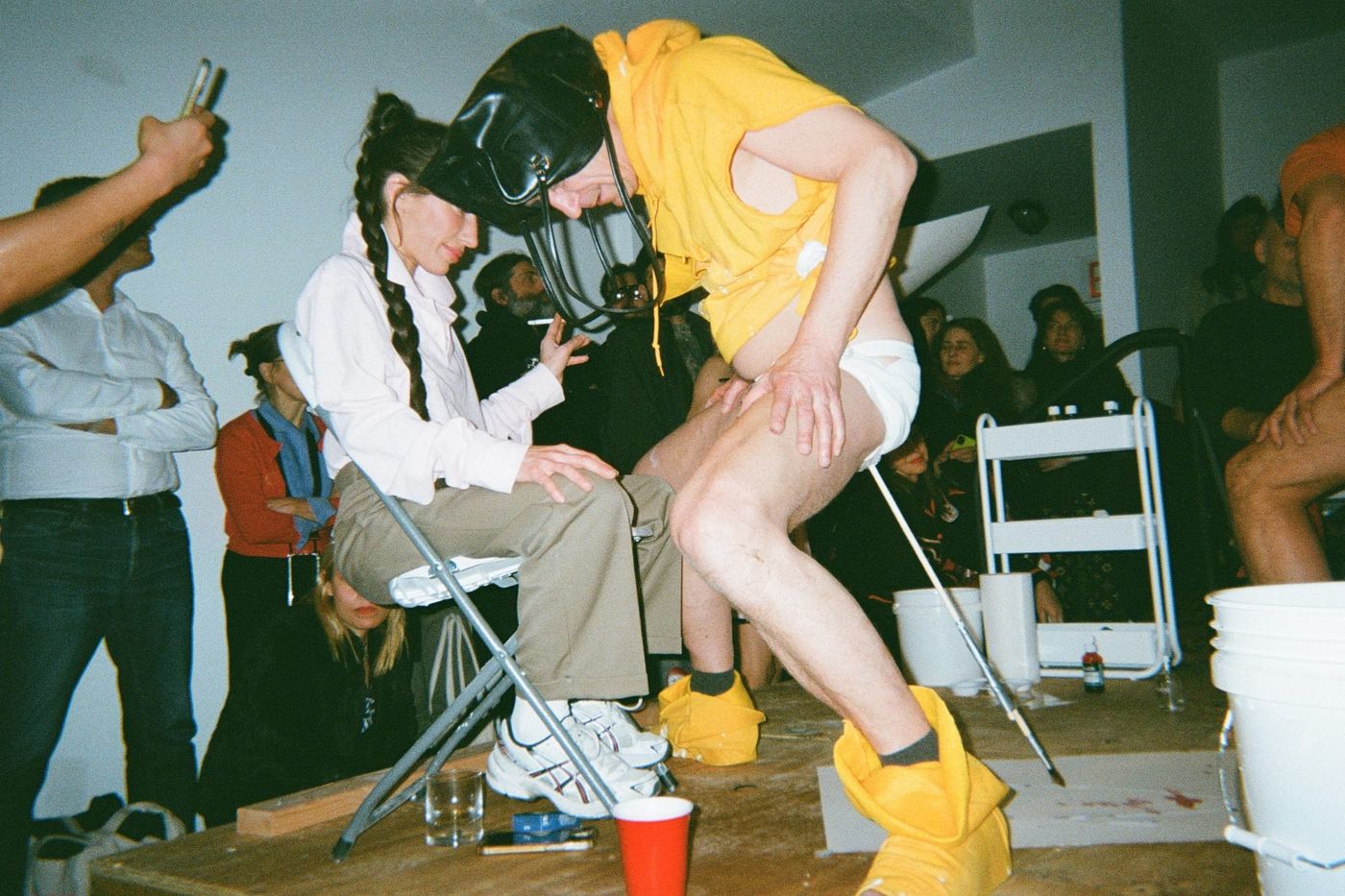
Juliano-Villani grew up in suburban New Jersey. Her parents owned a silk-screening factory that made store signs and printed T-shirts for pop bands. Her step-grandfather was a Newark judge, then later the city’s mayor. She was a hustler even as a kid — as a teenager, she held two or three jobs at a time, folding tees at her parents’ factory, chauffeuring kids to snowboarding trips in her beat-up station wagon, and clocking hours at the YMCA. Her twin, Julianna, was the more conventional of the pair, content with Somerset County’s mall-and-lacrosse culture. (Now she lives in Connecticut with four kids.) Jamian was constantly rewiring objects around the house and sketching in a notebook. “We always said, ‘Julianna wears the pearls, but Jamian wears the leather jacket,’” her mother, Michele, told me. Jamian made the varsity cheerleading squad as a freshman, but after being shoved down the stairs by upperclassmen, she didn’t return. Instead, she spent time with Zarsky, a trans musician and painter who introduced her to the punk scene. “I took her under my wing,” Zarsky said. “It was just, like, a gut instinct in me. I had to shepherd her because I believed there was greatness there.” Art school was Juliano-Villani’s calling, and like any true hustler, she took a shortcut — borrowing some of Zarsky’s portfolio to get a full scholarship at Pratt. Her parents successfully pushed for Rutgers instead, reminding Juliano-Villani that “one day you’ll have to pay car insurance.”
The early 2010s were a good time to be a young hyped-up artist. Interest rates were low, stocks and real-estate prices were surging, and everyone was flush with cash, flooding the art market with money. Abstract paintings by emerging artists like Lucien Smith and Oscar Murillo were getting snatched up for tens of thousands of dollars apiece, then flipped for double that. And once people like Deitch noticed Juliano-Villani, others were eager to follow suit.
By 2013, she was making enough money to bring Grant onboard officially as her assistant. Eventually, the speculative bubble began to slow down, but she was already a made artist with the right friends in the right places. She signed with the Milan-based Massimo De Carlo, who began handling her European sales. “Massimo moves work, and he loves Jamian,” said the artist and former dealer Joel Mesler. In 2021, De Carlo asked her to curate her own show in Milan. She liked the experience so much that afterward, “she was like, ‘I want to do more of this. I want to open up my own art gallery, and you and Billy are going to run it with me,’” Zarsky said. Neither was convinced it would work out. (“We were like, ‘Okay, Jamian.’”) But she talked about it for a year, and one day she found a space on 4th Street and Avenue C. “She’s like, ‘I found it. I paid for it. It’s happening.’” It was only $5,000 a month. By September 2021, the three had opened O’Flaherty’s. (The name came from her parents, who used to call her Jamian O’Flaherty; apparently she wasn’t Italian enough.)
The gallery was an attempt to do something “beyond my cheeseball paintings,” she once said. The plan was to sign a one-year lease and close it “before it sucks.” Her timing was excellent: It was post-pandemic, and young downtown New Yorkers were bored and eager to transgress. “There’s a whole class of collectors and curators who spend their lives going from Frieze to Art Basel,” said Russeth. “And no one fucking goes to gallery shows anymore. And here comes Juliano-Villani: ‘I got my friends and I got some money, and I’m just gonna try to do some cool shit and, like, throw some parties.’” O’Flaherty’s business cards were purportedly emblazoned with the words A FAT GUY, A TRANNY, AND A GUIDO walk into a bar. Its motto was “If you were going to die in a month and had to do a fucked-up show, what would it be? You can’t do anything wrong.”
O’Flaherty’s shows were never about peddling the next big thing out of the M.F.A. machine. The first was a solo show with Kim Dingle, a 73-year-old artist whose work focuses on traditional American life. This one centered on a baby doll and a crib crashing through the wall. “Kim had installed part of the show,” Zarsky recalled, “and Jamian spent one night rear-ranging things. Kim came in the next day and was not happy.” To salvage the situation, a security camera was installed to keep tabs on Juliano-Villani’s antics. “The baby show needed a babysitter,” she said. The show caught the attention of The New Yorker, which wrote, “The main room, strewn with cans of White Claw and broken scissors, suggests a wild party at which no one is checking I.D.s.”
Their second, a few months later, was called “Getting Chippy With It.” This time, the centerpiece was three tables in the shape of Black women by the artist Bjarne Melgaard; Juliano-Villani surrounded it with chip bags, in which she put battery-operated cat toys. The bags jumped around the floor, brushing against people’s ankles. The press release read, “What do rare crisps, or chips (depending where you are from), have to do with politically loaded sculptures that have already dated themselves? Getting Chippy With It presents viewers with this seemingly irreverent proposition … a reminder that we must be conscious of how we are shaping the world; while also cognizant of the dangers of censorship.” Zarsky said, “The idea was to push it so far that it kind of negates its offensiveness.” Juliano-Villani booked strippers for the after-party. Later, Dingle told this magazine, “I despise the shit show at O’Flaherty’s. It is racist and misogynistic and embarrassing.”
Juliano-Villani decided she wanted her third show to be with Bickerton, a Bali-based mixed-media artist she admired. “I just DM’d him, asking to do a show at O’Flaherty’s,” she said. “And then we just kind of really clicked.” During this time, “Ashley became Jamian’s mentor,” Zarsky said. “The good thing was there was a 13-hour time difference with Bali, so I’d call him in the witching hour, which is when I’m really fucked up,” said Juliano-Villani. A few months after they met, and a few months before the show they’d been plotting at the gallery, Bickerton was diagnosed with ALS. They pushed forward anyway. He arrived in New York in January 2022, and she made the opening a party. Deitch came; so did Larry Gagosian. “When an artist dies, their work is worth more. Larry showed up like he was bobbing for dead-artist apples,” said Zarsky. “It was a big sale. We were able to retain those funds to do the next couple shows,” said former O’Flaherty’s employee Rory Hayatgheybi. According to Zarsky, one piece went to Sylvester Stallone. Bickerton died in November 2022, only ten months after the opening. Gagosian subsequently announced he was handling Bickerton’s estate.
In July 2022, Zarsky, in addition to working sales and managing the gallery, was given the chance to organize a show of her own. Zarsky suggested bringing the transgender Canadian performance artist Nina Arsenault to live in the gallery for a month in a litter box made of thousands of pounds of sand. Juliano-Villani didn’t like the idea. “This person had been living as a homeless person in Canada. She had two Ph.D.’s. She was going to come to the gallery, live in the gallery, and read her book over and over. It just sounded so political and boring,” Grant said. “We don’t do politics,” Juliano-Villani added. She fired Zarsky and abandoned the idea. “They were just like, ‘We hate performance art. This show sucks,’” Zarsky said. “To me, it felt like she snapped out of this ketamine hole and turned to me and said, ‘You’re fired. I can’t do this anymore. I can’t stand you.’ I’d done so much for her, and she just treated me like garbage.” (Juliano-Villani said Zarsky quit.)
With Zarsky gone, Grant and Juliano-Villani regrouped. “I personally work better without Ruby,” Grant said. “They were always bullying me, calling me an incel. Jamian and I work faster: There’s no drama; we cancel ideas and move on quickly; nothing is personal.” Within 24 hours of firing Zarsky, they thought up “The Patriot,” a group show that accepted anyone’s submissions; they put out the call on Instagram and through word of mouth. They received 1,128 pieces; Hayatgheybi jammed artworks into every available crevice, ceiling, and bathroom. Jordan Wolfson exhibited his work; so did I, a three-by-four-foot canvas of a three-breasted alien at the North Pole. Juliano-Villani contributed $8,000 for a team of programmers to train a robotic monkey to do push-ups and pull-ups. When the battery made it too heavy, they set it, kicking, in a litter box. They displayed what they said was Abraham Lincoln’s death pillow behind a glass case, and the monkey programmers figured out a way to make the floor vibrate when you looked at it up close. Before the show, Juliano-Villani decided they should turn off all the lights and give visitors flashlights to navigate the space. “Jamian called it ‘Shitty Six Flags,’” said Hayatgheybi. The line stretched several blocks; inside, visitors got lost in the dark. “It was the longest line I’ve ever seen to try to get into an art exhibition in New York,” Deitch told me. The police department showed up less than an hour after the opening and shut it down. Juliano-Villani screamed at people to get out as they clapped and cheered her on. The next day, Grant called me and told me they’d sold my piece. Then he Venmo’d me $500.
For her own work, Juliano-Villani was still showing at JTT, but as O’Flaherty’s grew, she and Tsou began to fall out. “She thought I was out of control,” Juliano-Villani said. She began talking to Levai, who had recently opened the Ranch in Montauk after parting ways with Marlborough. There, she hosted an art show “with” her deceased hero, Mike Kelley. She showed paintings of crowds waiting to board the Hampton Jitney (“It really looks like people entering hell,” she said at the time) and a mother removing lice from a child’s head; the former was put near Kelley’s sculpture of a winged blonde man gagged and made into a chandelier fixture. The whole thing culminated in a whiskey-fueled egg hunt. Whoever found the egg would win one of her Jitney paintings. Dotted all around the yard were signs that Juliano-Villani had made: GOTTA FIND THAT EGG! “People were ravenous,” said the art reporter Annie Armstrong. Mid-hunt, and in an attempt to find the egg, the artist Brad Troemel wandered over to neighboring property, which happened to belong to the gallerist Adam Lindemann. He climbed Lindemann’s fence and broke it, resulting in a protracted feud. An 8-year-old ended up finding the egg, which Juliano-Villani had intentionally nestled in an area infested with chiggers and ticks. The child didn’t want the painting, so the gallery bought it back from him. Juliano-Villani and Levai got covered in bites. That weekend, Juliano-Villani was also invited to Gagosian’s Hamptons home for lunch, where she said she told him, “Let’s do a fucking show.”
Soon after “The Patriot” closed in September 2022, O’Flaherty’s was kicked out of its Avenue C location. And soon after that, Bickerton died. The timing wasn’t ideal. The plan was for Juliano-Villani and Gagosian to hold a joint memorial at the gallery, but now they didn’t have a space. She and Zarsky were spending time together again, and for months the trio were back to real-estate shopping. When Grant went to visit his family in Virginia for Christmas, Juliano-Villani called and told him not to come back. “She went full Kanye,” he told me. “I was fighting her about these crazy-expensive spaces. We were barely scraping by, and she’s looking at $30K-a-month places. I just needed a break, man. I had a lesion on my back from sleeping on couches for a year.” With Zarsky in and Grant out, she signed a ten-year lease on the old Upright Citizens Brigade Theatre on Avenue A and 3rd Street for $21,000 a month. It had slanted floors, not ideal for a gallery, but everything went as well as she had hoped. They had the memorial at the new space; later, Gagosian would host a Bickerton solo show. “It was a seamless transition,” said Zarsky.
That February, O’Flaherty’s officially reopened with the Austrian art troupe Gelitin, whose performance included live rectum paintings. (They clenched extra-long paintbrushes in their anuses.) It was a success, but Juliano-Villani was burned out, Zarsky said. She hadn’t yet secured the Gagosian show she hoped for and still had plenty of others to make work for — a group show in London, another in Beirut. “We were working in the gallery by day, then at Jamian’s studio at night. She had to make paintings to fund the gallery. So we’re high in the middle of the night, emailing dimensions of paintings to China, barely remembering what we sent. Then, months later, the paintings just show up, and we’re like, ‘Oh yeah, we did that,’” said Zarsky. It was chaos, a grind seven days a week. By the time the Gelitin show wrapped, Juliano-Villani was unraveling. “We were on fire,” Zarsky recalled. “She was barely sleeping, we were doing a lot of drugs, and Gagosian was stringing her along, dangling these carrots. It was driving her crazy.”
Juliano-Villani and Zarsky’s relationship fell apart again. “They’d been partying hard. Everything was blurring together,” said Hayatgheybi. Eventually, Juliano-Villani went home to New Jersey. Her parents started looking into her finances and found them a mess. “I had to go to all these banks,” her mother told me. “We had to close all the accounts. People were taking money without her even knowing it, right?” Juliano-Villani had been spending a lot, too: “She booked a trip for more than $10,000. I called, I got the refund, but we were very concerned.” Her father stepped in to assess the financial wreckage. “Her dad called and said, ‘I’m getting rid of her apartment, her studio. And you’re fired,’” said Zarsky. Hearing all of this from Virginia, Grant promptly flew back. “It was a mess,” he said. “That second location was an unrealistic dream, there was no money left, they had purchased a $40,000 stereo system, and I had to fix everything. But that’s kind of the charm, right? That’s O’Flaherty’s. That’s what makes it exciting, even when it’s exhausting.”
In late April 2022, Juliano-Villani came back to the city. She had gotten out of her studio, and apartment, but not the gallery. For a few weeks, she drank less hard liquor. Gagosian offered her the solo show they had been talking about for the better part of a year. “Which — it’s a big fuckin’ deal,” she told me later. “Gagosian, that’s fucking huge.” For months leading up to the exhibit, she and Grant ran O’Flaherty’s by day and worked on top-secret images at the gallery at night. Zarsky went to the opening. “I watched her do this Gagosian show and thought, You’ve made it. It’s blue skies from here. But she’s never satisfied,” she said. “She’s always one breakdown away from the edge. That’s Jamian.”
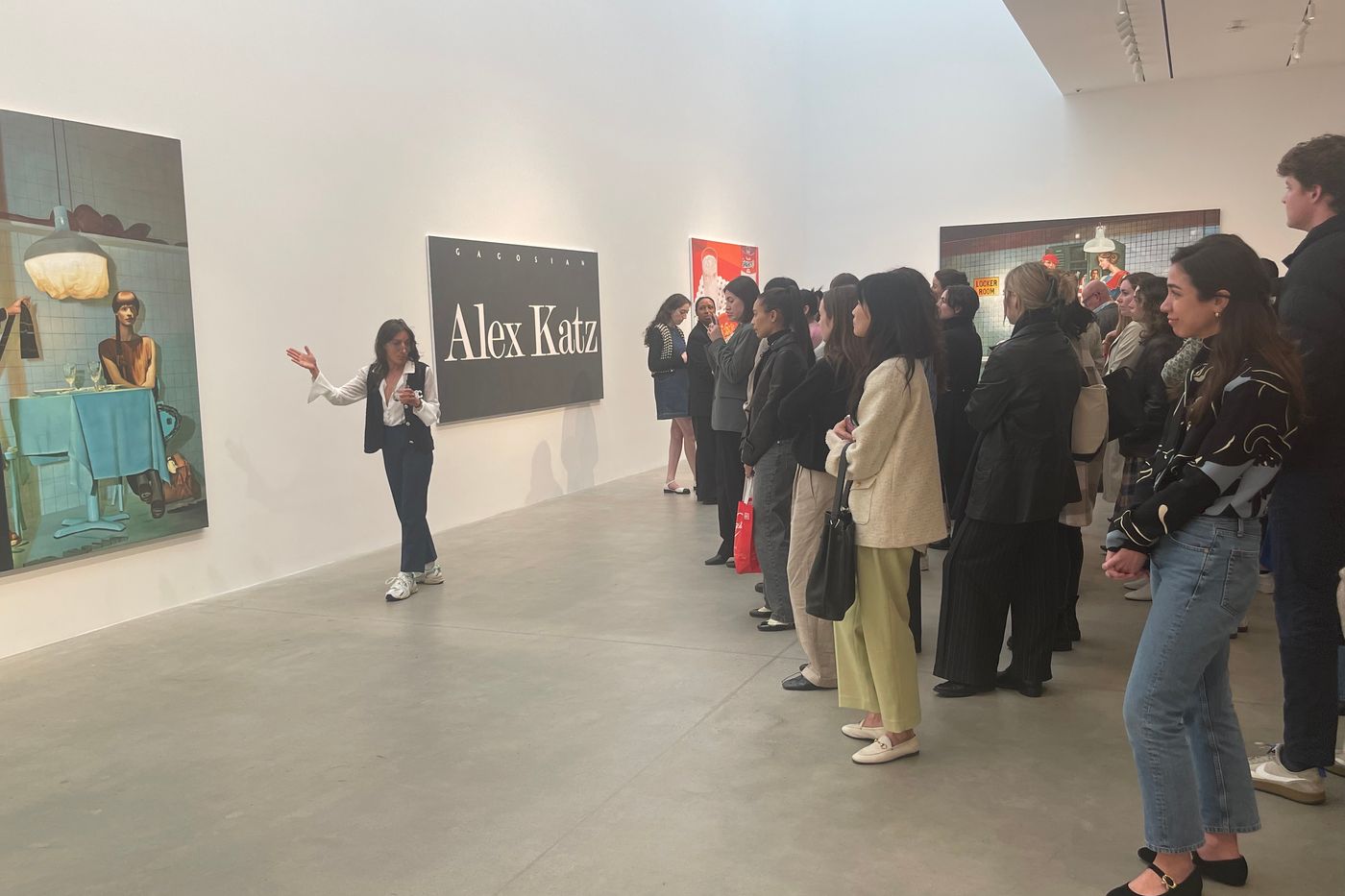
On the last day of her Gagosian show, April 20, I stopped by to meet Juliano-Villani for a private tour. A crew of slick and angular Gagosian publicists and gallerists met me at the front desk, offering cappuccinos. “Let’s smoke a cigarette,” Juliano-Villani said, so we slipped outside. People trickled in, trying to catch a final glimpse. Before we went back in, she changed her mind about the tour entirely. “Let’s do this next week,” she said. The following Wednesday, we came back without the public, just the two of us amid her work. She’s in gold frames with clear lenses, an oversize brown V-neck sweater, a crisp white popped collar half-tucked into jeans, and platform running shoes. If the paintings have anything in common, it’s their deliberate flatness, a feeling that they could all be hanging above the bed in a no-name roadside inn. In front of the painting of I Spy Henry Kissinger, she said, “I’m thinking cinematically. They all exist as one painting. But I hate having a style. I have to make this shit to make the other shit. I need this all to sell for O’Flaherty’s to survive so the party can continue.” The reviews for the show had been mixed, but the pieces apparently sold well, reportedly in the five and six figures. She sprawled out on the front desk in a power pose. “It’s supply, but it’s demand too, motherfucker,” she said to me.
A few nights later, I rolled up on Grant and Juliano-Villani at the gallery. They were riffing on ideas for their next act. I thought she’d be flush with cash after her Gagosian show, but she told me she’s drowning in debt: “I’m not seeing most of it! $250,000 has to go into my taxes. And now I’m stuck in a ten-year lease with this fucking place.” Their ideas haven’t been panning out either. “We were gonna do a show with Kanye, but he’s doing porno now,” Juliano-Villani said. They went one for one on everything: cig-cig, Corona-Corona, shot for shot. They talked about turning the place back into a movie theater, until we stepped outside and the fluorescent lights from the smoke shop next door gave them an idea. “We need to make money, so let’s sell weed. Fuck it. We’ll work with the weed guy next door,” Juliano-Villani said, slamming a stolen shopping cart into the gallery’s front door. We spent the next few hours designing Dutch Masters blunt boxes, and Grant posed as the Dutch Master himself. Juliano-Villani got on Photoshop, and we plotted O’Flaherty’s as a full-on dispensary, spoofing on all the illegal smoke shops. It got late, and we’d smoked a half-ounce; I had to go to sleep. I walked down the street and looked back, the cigarette smoke illuminated by the weed shop, and I knew tomorrow there would most likely be a completely different idea.
A week later, Juliano-Villani called me at midnight, her voice cracking with panic: “I’m locked in the fucking gallery! You gotta come help me!” I sprinted down Avenue A. When I got there, the gate had jammed halfway down, trapping her inside like a rat in a cage. She wore a ’70s polyester leisure suit like Mr. Roper from Three’s Company. “I’m a retard,” she muttered over and over. I grabbed the gate and yanked it open; we went inside and sat down. Grant, MIA, FaceTimed us from a hammock in Mexico, his first vacation in years. He was holed up with his mother and sister trying to detox from the madness of back-to-back shows. Juliano-Villani was still running on fumes — wired on Adderall, nicotine, and weed. Her landlord wanted her out of her apartment because he found out about her dog, Tim. Speaking of Tim: “He’s a genius,” she said. “He’s on the cover of Artforum this month.” (In fact, one of her paintings of Tim was on the cover — he’s blended in with a Master floor fan and a painting within a painting of a monster.) Anyway: “Fuck my apartment — I just need to pay Billy!”
She took a safety pin, put it up her nostril, tickled her nose hairs, and sneezed like she was exorcising. “Try it!” she said, passing me the pin, eyes full of mischief. I made myself sneeze, and before I even recovered, she shouted, “Roll another joint! We’ll figure it out!” It’s always like this — manic, stoned, full throttle, no brakes. Kembra Pfahler, the infamous performance artist, showed up looking like an alien-surfer goddess. Juliano-Villani was still worrying out loud about not making enough to pay the bills. “You can’t judge yourself by your financial success,” Pfahler said, but Juliano-Villani wasn’t buying it. “How do we keep this going? I’ve got to make money somehow,” she snapped back. In a burst of inspiration or desperation — or both — Juliano-Villani dragged us down to the pitch-black basement, pointing to a roped-off corner by the fire exit. “This is the next show,” she declared, as though she had just solved the problem.
Juliano-Villani’s teeth hurt; they were coming loose. Her diet was a mess, and she emptied her bank account trying to order us Burger King. The next idea was the only thing keeping her upright. “Fuck this,” she said, lighting another joint. “I could do a show with any fucking retard that needs clout and make $8 million easy, but am I doing that? No. This gallery is my art too, and once it’s about money, it’s not about art anymore.” We sat for a while longer, drinking, smoking, laughing, kicking around ideas and playing the Godzilla Minus One soundtrack. It’s all spitballing with Juliano-Villani’s brain in overdrive as she tests out new material. I asked her about the dispensary idea, and she barely remembered what I was talking about.
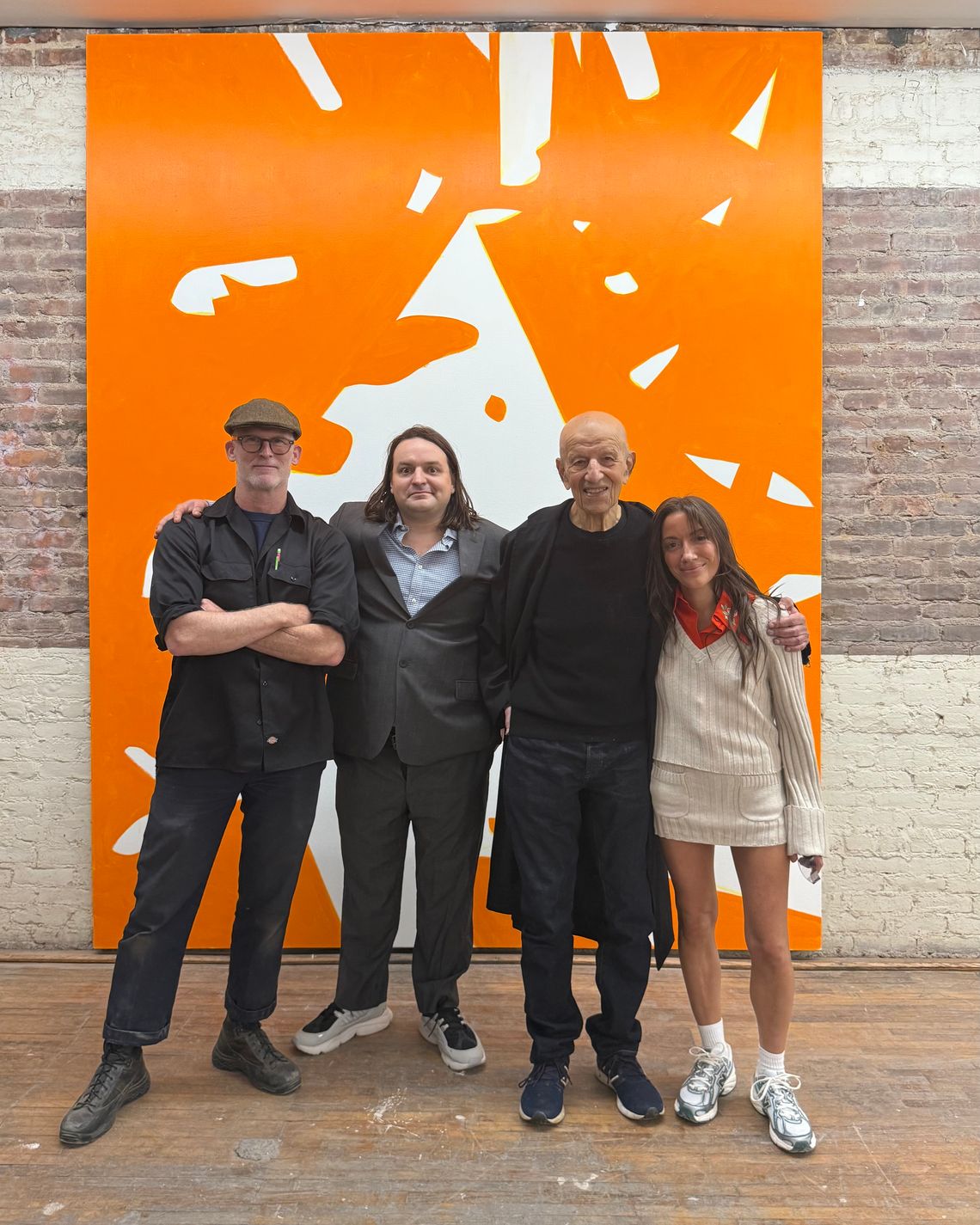
A few weeks later, the landlord let Juliano-Villani out of her lease on the UCB space. She had to scramble to close shop. She showed me photos on her phone of a building on Allen Street, a potential new O’Flaherty’s space, a former restaurant. “Probably full of asbestos,” she said. She didn’t care. “Enter at your own risk. I’m willing to die for this shit, motherfuckers.” We walked down Avenue A, passing the first O’Flaherty’s. “Spent almost six figures just storing Donna Dennis’s installation,” she said. “Billy threw out his back disassembling it.” We turned the corner on Stanton and found Grant on a sidewalk bench drinking Coronas. Juliano-Villani rattled off her upcoming shows: “Italy, London, and Gagosian wants something in Paris.” Her voice dropped. “Haven’t even started the work. It’s all a mess.” She was hyperfocused on doing a drawing show, and now she was looking at a boat in Connecticut; the idea was to stick a single pencil on it and call that a drawing. “Probably need a cabin boy,” she said, thinking out loud. “Gotta find someone who’ll live on the boat for free just to keep an eye on it.” It won’t be Grant — he told me he’s finally got his own apartment, a Williamsburg sublet he hopes to keep. “Feels great,” he said, lighting up a Newport. “I got a bed. First one in years. I’ve never lived alone before.”
That fell through, and a week later he was back to sleeping on Juliano-Villani’s couch. Like an old married couple, Juliano-Villani scolds Grant for “night eating.” She complained that they are “sexless retards,” adding, “I haven’t slept naked in two years.” This time, I found them outside Sugared + Bronzed near Union Square. “Let the tanner sizzle,” she reminded him. Juliano-Villani pulled out an earthquake detector, which she had bought for $90 on Amazon. Her eyes lit up as it flashed purple, green, yellow. “Teal’s fine, red is bad, green is neutral, and blue means an electromagnetic disturbance,” she told me. They had a new plan: to put on a show featuring two of the most famous living artists on earth, Alex Katz and Matthew Barney. She’d spent the past few years casually chatting up Barney about it — she knew him through Bickerton — and it seemed like it might actually happen. Barney was documenting Katz painting. The problem: Once again, there wasn’t a space for the exhibit. “They got to a point where they have these amazing American artists ready, and they’re like, ‘Let’s see the space.’ And for the first time in years, they didn’t have one. So they end up, like, having to find the new space and save the show. And that ended up being, like, the story of that October,” said Levai. “And who knows what’s going to be the story of January, right? That’s kind of the fun of it.” We passed the Double Down Saloon, the Mars Bar stand-in for Darren Aronofsky’s new flick, Caught Stealing, based on Charlie Huston’s 2004 novel. “I never rested on my laurels, and I never will,” Juliano-Villani said. “Just because I did something great doesn’t mean I can’t do something better next.”

Two days after Trump was elected, the show happened in O’Flaherty’s new space on Allen Street. I arrived early. It had been cleaned up since I saw the pictures; it was so white-walled and spare that if you squinted, it could be any blue-chip gallery — 52 Walker or even Gagosian. Behind the bar of the former restaurant, flat screens flickered with Barney’s video installation chronicling Katz at work. In them, the 97-year-old artist mixes paint and teeters up a ladder to his canvases. Upstairs, the actual Alex Katz stood in front of the Nickelodeon-orange abstract paintings he is creating in the videos. Gagosian surveyed the scene and shook hands with Barney. “Great work,” he said, and slipped out. The rest of us went out to the backyard. Grant wore a sharp suit; he seemed content. I asked Juliano-Villani if she wanted to hit the joint, but she declined. “I’ve gotta be professional,” she said. She glanced at the security guards standing at attention in various corners, wearing earpieces. Later, Klaus Biesenbach would show up. So would Mel Ottenberg. As if she were reminding herself this is still O’Flaherty’s — whatever that means anymore — Juliano-Villani stormed up to the sentinel she hired. “By the way, you can smoke in here,” she said. “Trust me, things are about to get crazy here.” But would it? Juliano-Villani turned to Grant. “How many years did we lose putting this on, Billy?” she asked him, referring to the black mold they cleared out of the place. “At least a few,” Grant said. “But I like it here. This place is Zen as fuck,” Juliano-Villani said, smoking a cigarette and surrounded by the yellow leaves of the stagnated fall. I began to ask what this show was all about, but before I could finish, she handed me the press release that Grant wrote and that she’d been reading over and over: “O’Flaherty’s is pleased to present ‘The Bitch,’ an exercise in their master craft. In the end, the work gets all the glory. The bitch is just the plan, and mostly gets all the blame.”
Related
Less than six months after her Gagosian solo show, the downtown artist-slash-gallerist lost her gallery and all her money.



